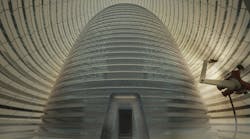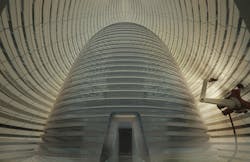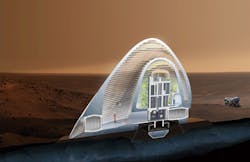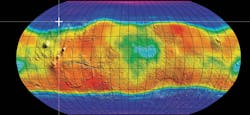NASA continues to award money to the 3D-Printed Habitat Challenge, a $2.5 million competition that requires contestants to design a 3D-printed habitat for deep-space exploration. While many acknowledge it will be some time until a human sets foot on to Mars, it has not stopped innovative minds from trying to find ways to build on the red planet.
Space is an extreme environment where resources are scarce, and blasting Earth’s resources into space is expensive. Anyone designing for space must make the tools and materials as minimal as possible, not to mention ensuring that they fit within a rocket.
This printer bot will form grooves so that it can climb the walls as it sprays on layer after layer of ice, creating a living space for astronauts before they arrive.
Currently, it looks like 3D printing a house on Earth is similar to what design teams have in mind for Mars. Concrete is considered the most-used construction material on Earth, and maybe why the top three finishers used a type of thermoplastic concrete material. This could be a way to harvest Martian dirt with a binder agent to construct buildings.
Reducing the amount of material that needs to be sent from earth is a key factor, and the focus of the second phase of the competition. This phase focuses on a recycling system that can create structural components using terrestrial and space-based materials and recyclables.
The first phase ended in September 2015. NASA awarded $25,000 to Team Space Exploration Architecture and Clouds Architecture Office, which collaborated to design the Mars Ice House. Phase one of the competition had participants develop state-of-the-art architectural concepts that take advantage of 3D printing. By using local and recycled resources, teams are demonstrating how it might be easier to put a house, rather than a person, on Mars.
The double-walled design will help keep contaminants out of the main living area and add another layer of protection.
We already know we can get things to Mars. If a 3D-printing device were sent, it could utilize not only the supplies in the ship, but the ship itself and the surrounding resources to build a hospitable environment. Using Martian rocks and dirt with a binder agent, a robot could harvest support beams from the spaceship. This may lead to the creation of a relatively large livable space long before humans ever reach Mars.
Radiation and Water Sources
A large concern for human life on Mars is the radiation exposure. While tunneling into the surface for shelter might be an easy fix, it might present substance hazards in the ground itself. The Mars Ice House team says a 5-cm ice shell can protect against radiation while staying above ground, away from potentially hazardous elements in the ground.
Furthermore, the team believes there is an abundance of water in the Alba Mons region of Mars that would be easy to access. This would eliminate the energy concerns and other challenges that might arise when mining or living in extraterrestrial soil. Water is scarce, but finding a large-enough source would eliminate the need to ship supplies of binder agents and water to Mars.
The Mars Ice House team says, “We now believe there to be an abundance of water in subsurface and exposed ice in the higher and lower latitudes. Site selection was determined by a multitude of parameters, including balancing access to a shallow ice table from the surface (within 20 cm to 1 m), with temperatures that remain below freezing throughout the Martian year.” Map data is from the 2001 Mars Odyssey gamma ray spectrometer.
As a side note, this means we may not be able to build an ice house on the equator of Mars until melting was factored in the equation. The surface of Mars at the equator has hit 20˚C at what would be considered noon, but the evenings are cold enough to replenish any melted walls. This may give way to research into ways to increase the temperature it takes to melt ice, such as adding salts and other minerals.
Water overall would be a great asset for many of the projects, let alone life on Mars. Water is lost through airlocks, the oxygen-generating system, and urine. Even though an astronaut’s urine is recycled, there is a small amount of unrecyclable brine. Just like expeditions of the past, once again it looks like traveling to a new home is harder than making one.
On the construction front, some teams have already 3D-printed load-bearing beams out of dirt similar to Martian dirt. And scientists may be able to experiment with these concepts sooner than expected—in 2020, NASA is sending out the Prospector mission to dig on the “dark side of the moon.” Perhaps we will learn something new and find minerals, such as heavy hydrogen, that might help us move farther into space.




